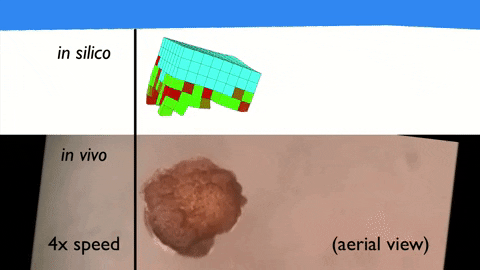By Michael Irving
Robots are made to mimic living creatures, and as smart as they’re becoming, we can still look at them and understand that they aren’t “living” in any real sense. But that line is now beginning to blur. Researchers at the University of Vermont and the Allen Discovery Center at Tufts University have essentially created new creatures from frog cells, complete with programmable behaviors.

The new living robots are made of skin and heart cells taken from frog embryos, assembled into stable forms designed by a supercomputer and set loose in a Petri dish. The skin cells work to give the little critters their shape – which kind of resembles a blob with four “legs” – while the heart cells push them around with every pump.
“These are novel living machines,” says Joshua Bongard, co-lead researcher on the project. “They’re neither a traditional robot nor a known species of animal. It’s a new class of artifact: a living, programmable organism.”

Each measuring 1 mm (0.04 in) long, the team calls their creation “xenobots”, after the Xenopus laevis species of frog that the cells were originally taken from. Tests showed that the organisms would swim around their environment for days or weeks at a time, running on stored embryonic energy. In groups, they tended to swim in circles and could even push pellets into the center of the space.
That might not sound all that impressive, but the team says that this technique is a proof of concept for living, reprogrammable machines. They can be custom-designed to accomplish a whole range of tasks, such as cleaning up the environment or even the human body.
“We can imagine many useful applications of these living robots that other machines can’t do, like searching out nasty compounds or radioactive contamination, gathering microplastic in the oceans, traveling in arteries to scrape out plaque,” says Michael Levin, co-lead researcher on the project.
Before they were ever a reality, the xenobots were first designed using the Deep Green supercomputer cluster. An “evolutionary algorithm” came up with thousands of possible designs for the living robots, and then ran simulations to determine which configurations were best at achieving a given task. Over multiple generations, the successful designs were refined until the computer settled on the xenobots’ current form.

Next, the researchers assembled the living things according to the computer’s blueprint. They gathered frog stem cells, isolated and incubated them, then cut and joined them under a microscope. As living organisms, the cells patched themselves up, creating the xenobots.
The team tested other versions, too. Some of the xenobots were made with a hole through their centers, to reduce drag. A simulated design that wasn’t made used this hole as a kind of cargo pouch, which could one day ferry drug molecules around.
Another advantage is that these living systems can self-heal. The team tested this by cutting some of them almost completely in half – and sure enough, they patched themselves back up and went about their day again. And after they complete whatever job they’re assigned to, the xenobots become just harmless dead cells that are fully biodegradable.
The xenobots represent a new stage in the creation of artificial life. Already, scientists have designed and created synthetic bacteria, semi-synthetic organisms with extra DNA base pairs, artificial embryos that don’t require sperm and eggs, and robots made using cells from rats or sea slugs. But this project marks the first time brand new biological machines have been created using forms that don’t appear in nature.
Source: University of Vermont

Leave a Reply